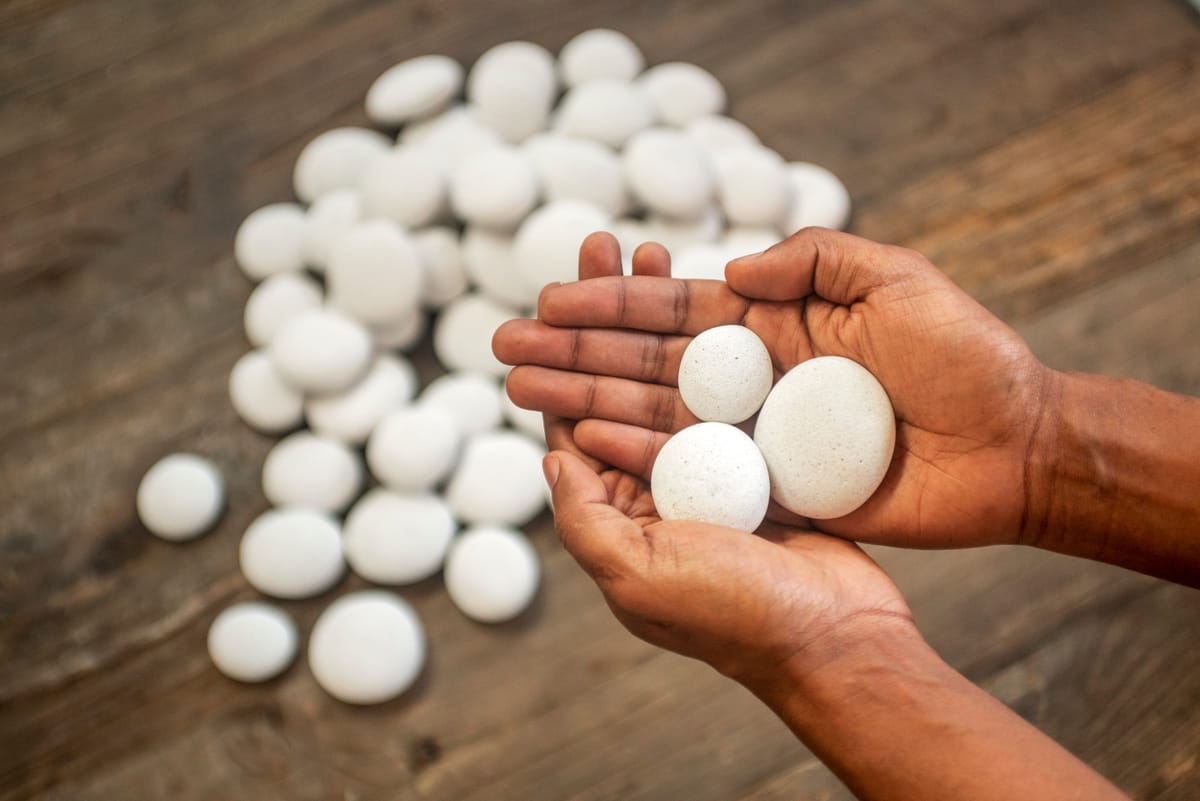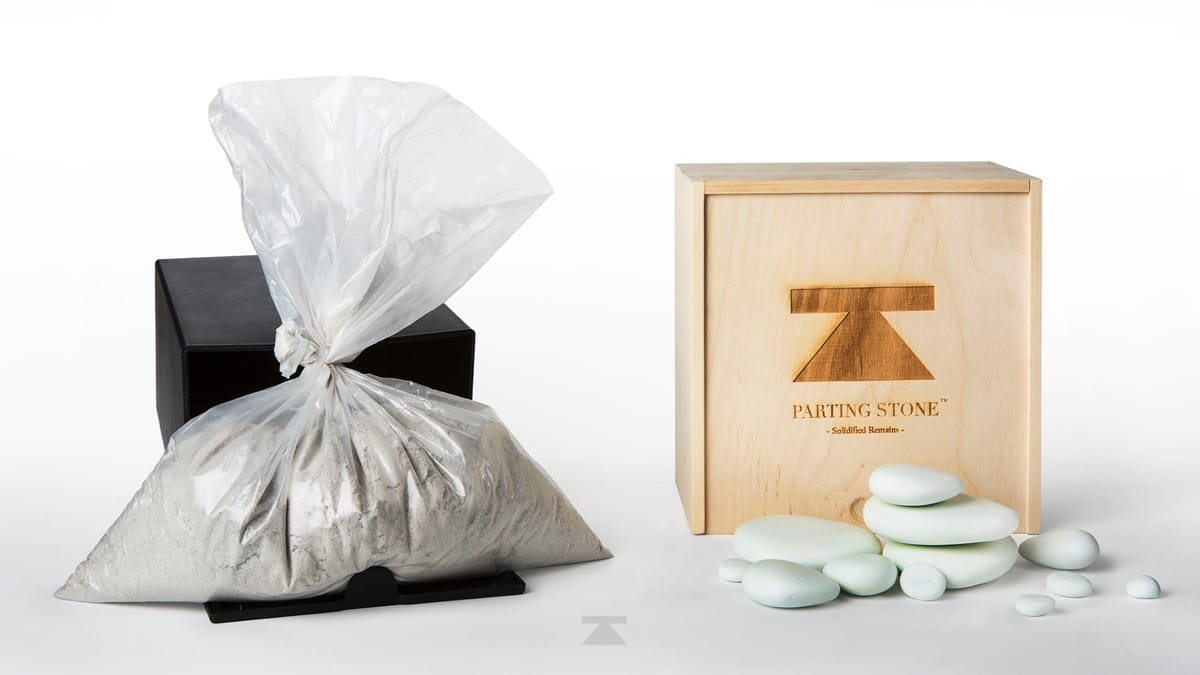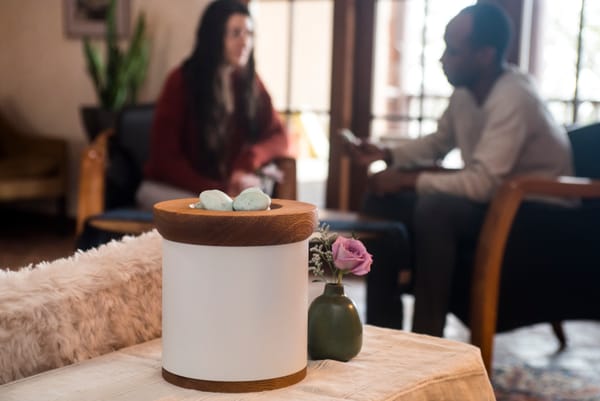How Ashes Become Stones: The Science Behind Solidified Remains
Discover the science behind turning ashes into solidified remains. Learn how Parting Stone transforms cremated ashes into beautiful, lasting stones.

Understanding the scientific process that transforms cremated remains into beautiful, permanent stones
Key Takeaways
- Solidified remains represent a complete alternative to traditional cremated remains, not an enhancement or product addition.
- The transformation process involves four scientific stages: refinement, formation, solidification, and finishing.
- Los Alamos National Laboratory partnership ensures the highest scientific standards and process integrity.
- The 8-10 week processing timeline allows for careful, individualized treatment of each family's remains.
- Each transformation results in 40-80 unique stones that families can hold, share, and cherish
The Hidden Problem Most Families Face After Cremation
When families choose cremation, they often discover an uncomfortable truth that no one prepared them for. The cremated remains they receive can feel impossible to live with comfortably. These ashes create barriers to connection rather than bringing families closer to their departed loved ones.
Cremated remains are messy and spill easily, contain visible bone fragments that can be distressing to see, and blow away unpredictably when families attempt outdoor scattering. Many families find themselves storing these remains in closets, basements, or garages simply because they feel too anxious or uncomfortable to keep them in their living spaces.
This hidden crisis affects approximately 75 million Americans who currently live with cremated remains stored away from daily life. Families desperately want to feel close to their departed loved ones, but conventional ashes often create anxiety rather than comfort.
Reflections on love, loss, and the ways we carry them.
In my years as a grief counselor, I’ve witnessed a quiet, often unspoken discomfort among families after cremation. They bring home an urn expecting peace, only to find unease. The ashes: powdery, uneven, sometimes containing bone fragments, feel too fragile to touch, too sacred to store away. So the urn is placed in a closet or under the stairs, waiting for the right moment that never comes.
One family I worked with kept their son’s ashes in a paper bag inside a cabinet for three years. They told me, “We love him too much to scatter him, but we can’t bear to open the urn.” That conflict between love and discomfort, is often one of grief’s hidden burdens
This is why the innovation behind solidified remains has moved me deeply. The process transforms cremated remains into smooth, stones that are solid, clean, and enduring. Each stone is unique, as if shaped by the person’s own story. When families hold them, they often say the same thing: “I can finally breathe.”
Solidified remains offer something ashes rarely can. They offer comfort through touch, and allow families to hold, share, and display their loved one’s memory in a form that feels both beautiful and permanent.
Grief will always ache, but when we can cradle memory in our hands, it softens the sorrow. And sometimes, that simple act - the weight of love made tangible, is what helps a family begin to heal.
Cathy Sanchez Babao
Parting Stone Grief Coach
What Are Solidified Remains?
Solidified remains represent an entirely new category in death care. Rather than being a product that uses ashes, this process creates a complete alternative form of remains. When families choose cremation, they can now choose between receiving cremated remains or solidified remains.
This scientific approach transforms the vast majority of cremated remains into smooth, stone-like forms that families can hold, share, and cherish. The resulting collection typically consists of 40-80 individual stones, each unique in size, shape, and natural coloring.
The Four-Stage Scientific Process
| Stage | Process | Scientific Focus | Timeline |
|---|---|---|---|
| Refinement | Remove contaminants, refine ash into fine powder | Materials purification and preparation | Weeks 1-2 |
| Formation | Add glass-based binder, create clay-like material | Binding chemistry and formability | Weeks 3-4 |
| Solidification | Controlled kiln heating for permanent hardness | High-temperature ceramic processing | Weeks 5-7 |
| Finishing | Cleaning, polishing, and quality control | Surface treatment and quality assurance | Weeks 8-10 |
The solidification process begins with careful refinement of the cremated remains. Trained technicians remove any foreign contaminants, such as medical implants, surgical staples, or screws, that may remain after cremation. The granular ash material is then gently refined into a fine, consistent powder. This refinement stage ensures the highest quality foundation for the transformation process.
During the formation stage, a small amount of glass-based binder is carefully added to the refined ash powder. This creates a clay-like material that can be formed into individual stones. The binding agent represents only a minimal addition to the original remains, allowing the vast majority of the cremated material to be preserved in the final stones. The formation process draws from multiple scientific disciplines, including pharmaceutical manufacturing, mineral processing, and ceramic production techniques.
The formed stones are carefully placed into specialized kilns for the solidification stage. This controlled heating process gives the solidified remains their ceramic-like hardness and permanence. The heating cycle has been precisely developed to ensure optimal transformation while maintaining the integrity of the original material. The temperature and timing protocols used in this stage are the result of extensive research and development conducted in partnership with materials scientists at Los Alamos National Laboratory.
The final stage involves careful cleaning and polishing of each stone. Quality control specialists examine every piece to ensure it meets the scientific and aesthetic standards families deserve. The finished solidified remains feel similar to natural river stones, with a clean, permanent surface that will not dissolve in water or scratch with fingernails. Each completed stone collection is carefully packaged and prepared for return to the family.

The Science Behind Los Alamos Partnership
The development of solidified remains technology involved collaboration with material scientists at Los Alamos National Laboratory, one of the world's leading research institutions. This partnership brought advanced materials science expertise to the challenge of creating a dignified, permanent form of remains.
Los Alamos scientists contributed their knowledge of high-temperature processing, materials composition, and quality control methodologies. Their involvement ensures that the solidification process meets rigorous scientific standards while respecting the emotional significance of the materials being transformed.
An environmental impact study conducted in conjunction with Los Alamos National Laboratory found that scattering solidified remains has a negligible environmental impact, especially compared to traditional cremated remains, which can substantially affect soil water and soil chemistry.
Understanding the Transformation Results
What Families Receive
Each solidification process results in a unique collection of stones reflecting the individual characteristics of the person or pet being honored. Families typically receive between 40 and 80 stones, ranging from thumbnail to palm-sized, each with its own natural shape, texture, and color.
The volume of solidified remains returned approximates the volume of cremated remains received. For example, eight cups of conventional cremated remains will return approximately eight cups of solidified remains in stone form.
The Unique Nature of Each Collection
One of the most remarkable aspects of the solidification process is that each stone emerges differently. The natural variations in cremated remains, combined with the scientific transformation process, create stones with unique characteristics that reflect the individual being honored.
No two collections are identical, and the process cannot be customized to create specific shapes or colors. This natural variation ensures that each family receives stones that are truly unique to their loved one.
Quality Assurance and Process Integrity
Every order receives completely individual processing to maintain the highest standards of integrity and respect. Parting Stone uses individualized equipment for each step of the process, ensuring that remains are never mingled or combined with other families' materials. A single trained technician handles each family's remains throughout the entire transformation process, maintaining continuity and accountability from beginning to end.
The comprehensive quality assurance approach includes:
- Individual order processing with dedicated equipment for each family
- Single technician continuity throughout the entire 8-10 week process
- Email notifications at key stages to keep families informed
- Detailed documentation and tracking for complete transparency
- Chain of custody protocols ensuring integrity from receipt to delivery
- Final quality control inspection before return to families
This systematic approach helps build confidence and trust during what can be an emotionally challenging time. Families can have complete confidence that their loved one receives individual attention and respectful treatment throughout the scientific transformation process.
The Environmental Science
Sustainable Transformation
The solidification process produces no harsh chemicals or harmful emissions during transformation. While the kiln heating does require energy, the overall environmental impact remains minimal compared to many traditional memorial options.
Long-term Durability
The ceramic-like properties of solidified remains ensure they will maintain their integrity indefinitely. Unlike traditional cremated remains, which can be affected by moisture, wind, and environmental factors, solidified remains offer permanent stability.
This durability means families can create lasting memorials, whether they choose to keep stones together, share them among family members, or place them in meaningful outdoor locations.
Why Scientific Approach Matters
Evidence-Based Development
The development of solidified remains technology represents years of scientific research and testing. This evidence-based approach ensures that families receive a reliable, high-quality transformation that honors their loved one with dignity and respect.
The scientific methodology addresses common concerns about memorial options by providing a solution that is both emotionally meaningful and technically sound.
Professional Validation
Over 600 funeral home partnerships demonstrate professional endorsement of the solidification process. These relationships reflect the confidence that death care professionals have in the scientific validity and emotional appropriateness of solidified remains.
More than 10,000 families have successfully received solidified remains, providing extensive real-world validation of the process and its outcomes.
Frequently Asked Questions
What scientific process turns cremation ashes into stones?
The solidification process involves four stages: refining cremated remains into powder, adding a glass-based binder to create formable material, heating in kilns for permanent hardness, and finishing with cleaning and polishing. This transformation takes 8-10 weeks and results in 40-80 permanent stones.
How can I be sure the stones are made from my loved one's remains?
Every order receives individual processing with strict chain of custody protocols. A single technician handles your loved one's remains throughout the entire process using individualized equipment. No remains are ever mingled, and detailed tracking ensures complete integrity.
What happens if I don't have the full amount of cremated remains?
The process can accommodate partial amounts of cremated remains, requiring a minimum of one-quarter cup to complete the transformation. If you have already scattered some remains or have only a portion available, the solidification process will transform whatever amount you provide.
Are there any chemicals added to the cremated remains?
Only a small amount of glass-based binder is added to create the clay-like material needed for stone formation. No harsh chemicals are used, and no harmful emissions are produced during the process. The vast majority of the final stones consist of the original cremated remains.
How long do solidified remains last?
Solidified remains have ceramic-like properties that ensure permanent durability. They will not dissolve in water, cannot be scratched with fingernails, and will maintain their integrity indefinitely. They are designed to outlast traditional memorial options.
Can I specify the number or appearance of stones I receive?
The solidification process creates natural variations that cannot be customized. Each person's remains produce a unique collection of stones varying in size, shape, color, and texture. The number typically ranges from 40-80 stones, but exact counts cannot be predetermined or requested.
What is the cost and timeline for solidification?
The processing timeline is 8-10 weeks to ensure proper scientific methodology and quality control. Pricing information is available through funeral home partners or directly through Parting Stone's website, as costs may vary based on specific service options.
Can solidified remains be scattered like traditional ashes?
Yes, solidified remains are excellent for scattering without the mess and unpredictability of conventional ashes. The stones can be placed in meaningful locations, travel easily, and won't blow away in wind or dissolve in water.
Moving Forward with Understanding
The transformation of cremated remains into solidified remains represents a fundamental shift in how families can experience their relationship with departed loved ones. This scientific process offers a solution to the hidden problems that many families face with conventional cremated remains.
Understanding the methodology behind solidification can help families make informed decisions during a difficult time. The combination of scientific rigor and emotional sensitivity ensures that this option serves families who seek both technical validation and meaningful connection.
For families who have felt uncomfortable with traditional cremated remains or who seek a more tangible way to maintain their connection to departed loved ones, solidified remains offer a complete alternative backed by rigorous scientific development and proven results.
The 8-10 week processing period allows families time to prepare emotionally for receiving their loved one in this new form, while the scientific approach ensures they can have complete confidence in the integrity and permanence of the transformation.







